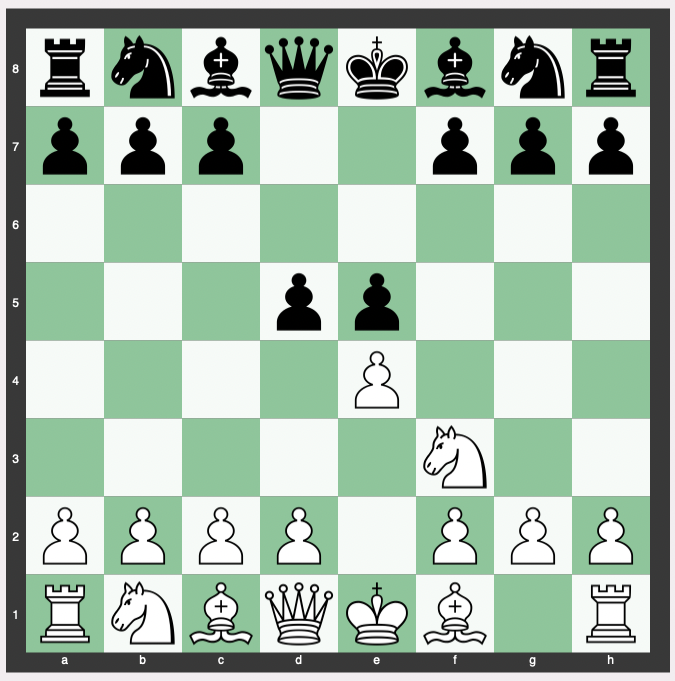The Elephant Gambit is a non-standard chess opening that walks a fine line between audacity and recklessness.
It’s an aggressive gambit characterized by its early challenge to white’s control of the center, thereby undermining conventional opening principles.
While it may not be the darling of the grandmaster community, the Elephant Gambit offers players the ability to plunge games into uncharted waters and often catches opponents off guard with its unorthodox approach.
Elephant Gambit Move Order
The Elephant Gambit is a chess opening characterized by a specific sequence of moves.
The move order is 1.e4 e5 2.Nf3 d5, a sequence that breaks with traditional opening theory principles by immediately striving to challenge white’s control of the center.
The position appears as such:

Strategy and Purpose of the Elephant Gambit
The primary strategy of the Elephant Gambit is to disrupt white’s game plan from the onset.
The gambit aims to drag the game into unfamiliar territory, thereby causing the opponent to expend time and energy in navigating the unique position on the board.
The second pawn move by black (2…d5) is designed to provoke a response from white, ideally resulting in a pawn exchange that complicates the game and increases the chances of a mistake on the part of the white player.
Evaluation of the Elephant Gambit
Top chess engines like Stockfish will generally evaluate white’s advantage after 2.d5 as around +1.2 to +1.4.
It suggests taking the pawn on d5 right away.

Variations of the Elephant Gambit
There are multiple variations to the Elephant Gambit, all of which add further layers of complexity to the game.
Declined Variation
One of the most popular variations is the Declined variation, where white does not take the pawn offered but instead continues to develop the pieces in a regular fashion.
Accepted Variation
The Accepted variation, where white captures the d5 pawn, is also frequently seen.
In the latter, black often responds with Qxd5, swiftly bringing their queen into play at the cost of violating the traditional principle of delaying queen development in the opening.

Modern theory, however, suggests that black advance the e-file pawn to attack the f3 knight on move 3 (which then white will typically respond to by moving its queen to e2, preventing the capture of the knight due to a check that would result).

Continuations of the Elephant Gambit
If played at the grandmaster level, potential Elephant Gambit lines that might follow include:
3. exd5 Qxd5 4. Nc3 Qd6 5. d4 exd4 6. Nxd4 Nf6 7. Ncb5 Qe5+ 8. Qe2 Qxe2+ 9. Bxe2 Na6 10. Bf4 Bc5 11. O-O-O O-O 12. Bf3 c6 13. Nd6
3. exd5 Qxd5 4. Nc3 Qd6 5. d4 exd4 6. Nb5 Qe7+ 7. Qe2 Na6 8. Nbxd4 Nf6 9. Bf4 Qxe2+ 10. Bxe2 Nd5 11. Bg3 Bb4+ 12. c3
3. exd5 e4 4. Qe2 Nf6 5. d3 Qxd5 6. Nbd2 Nc6 7. dxe4 Qe6 8. Qc4 h6 9. c3 Qe7 10. Nd4 Bd7 11. f3 O-O-O 12. Nxc6 Bxc6 13. Nb3 Nd7 14. Na5 Ne5 15. Nxc6 Nxc6
3. exd5 e4 4. Qe2 Nf6 5. d3 Qxd5 6. Nbd2 Nc6 7. dxe4 Qe6 8. Qc4 Qg4 9. h3 Qg6 10. e5 Be6 11. Qa4 Nd7 12. Bd3 Nc5 13. Qxc6+ bxc6 14. Bxg6 hxg6 15. Nd4 Rh5 16. N2f3 Bd5 17. O-O Na6 18. Rd1 c5 19. Nb5 Bxf3 20. gxf3
3. exd5 e4 4. Qe2 Nf6 5. d3 Qxd5 6. Nbd2 Nc6 7. dxe4 Qe6 8. Qc4 Qg4 9. h3 Qg6 10. e5 Be6 11. Qa4 Nd7 12. Bd3 Nc5 13. Qxc6+ bxc6 14. Bxg6 hxg6 15. O-O Rh5 16. b3 a5 17. Bb2 a4 18. Rfd1 Bd5 19. c4 Bxf3 20. Nxf3 Ne6 21. Bc3
3. exd5 Qxd5 4. Nc3 Qd6 5. d4 exd4 6. Nb5 Qe7+ 7. Qe2 Na6 8. Nbxd4 Nf6 9. Bf4 Qxe2+ 10. Bxe2 Bb4+ 11. c3 Nd5 12. Bxa6 Nxf4 13. Bb5+ c6 14. Nxc6 Nxg2+ 15. Kf1
History
Despite its unusual and aggressive nature, the Elephant Gambit has never gained significant popularity among top players due to its perceived lack of soundness.
However, it has enjoyed some measure of success in club-level games and among amateurs who appreciate the element of surprise it brings to the board.
Whether It’s Good for Beginners or Intermediates
While the Elephant Gambit offers some interesting strategic opportunities, its use is generally not recommended for beginners.
The gambit requires a nuanced understanding of chess tactics and strategies, as well as a good deal of creativity and resourcefulness to exploit the opportunities it presents.
It can be better suited for intermediate players looking to try unconventional openings and willing to venture into less-charted territories of the game.
How Often It’s Played at the Grandmaster Level
The Elephant Gambit is infrequently played at the grandmaster level. Its lack of popularity among top players stems from its perceived unsoundness.
The gambit gives up a pawn in the opening, a material disadvantage that top-level players can typically exploit with precision.
Nonetheless, it has been seen occasionally in grandmaster play, often as a surprise weapon to throw off an opponent who might be prepared for more conventional openings.
However, it is risky to play against a prepared opponent.
Beating an IM in 9 Moves with the ELEPHANT GAMBIT
Conclusion
In the world of chess, the Elephant Gambit remains a fringe opening, yet one filled with possibilities for creative players willing to depart from traditional strategies.
Although it is not commonly employed at the grandmaster level due to its perceived unsoundness, it can offer fascinating games when played by intermediate players who understand its nuances.
The Elephant Gambit serves as a reminder that even in a game as ancient and as deeply studied as chess, there is still room for originality and surprise.


